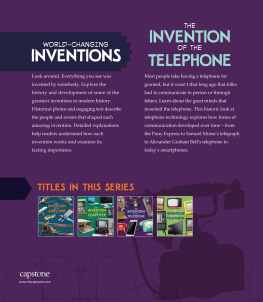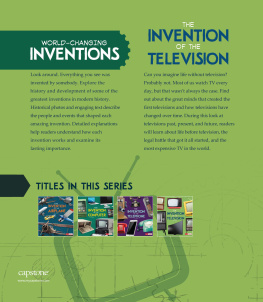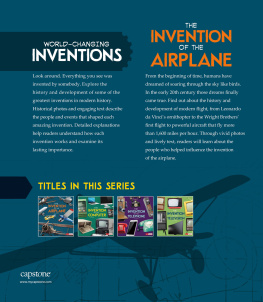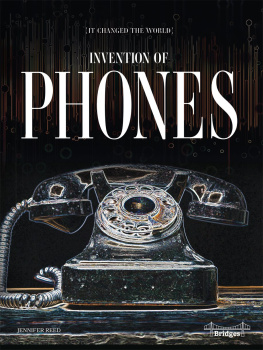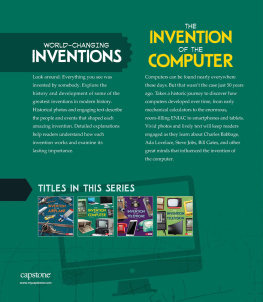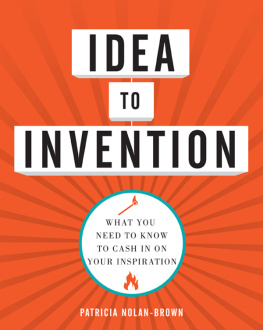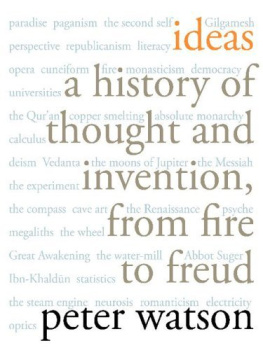Michael M. Dediu
Archimedes to Ford: Invention History celebrated after 1943
A chronological and photographic documentary
DERC Publishing House
Tewksbury (Boston), Massachusetts, U. S. A.
Copyright 2019 by Michael M. Dediu
All rights reserved
Published and printed in the
United States of America
On the Great Seal of the United States are included:
E Pluribus Unum (Out of many, one)
Annuit Coeptis (He has approved of the undertakings)
Novus Ordo Seclorum (New order of the ages)
Library of Congress Control Number: 2019904108
Dediu, Michael M.
Archimedes to Ford: Invention History celebrated after 1943
A chronological and photographic documentary
ISBN-13: 978-1-939757-88-3
Preface
From Plato it is well known, for over 2360 years, that the necessity is the mother of invention. Then Archimedes, over 2230 years ago, clearly stated: Give me a lever long enough and a fulcrum on which to place it, and I shall move the world, and There are things which seem incredible to most people who have not studied Mathematics.
Starting with the invention of languages, Archimedes screw, and Heron engine, there are many wonderful discoveries presented here, which help us to understand how we arrived at the current advanced level of technology. Do you remember Huygens, Hertz, Cartwright, Volta, Babbage and Cerf? They, and many others, will be happy to tell you about their inventions. Is there a connection between The Count of Monte Cristo and Chappes invention? This book will surprise you.
Starting from 1943, in a chronological order, we present the invention history, which was commemorated in the last 76 years. There are also many attractive and historic photographs I want to thank my wife for her photo assistance.
This book, for the general public, reminds us of the influential innovators who changed our world, and offers a variety of relevant information not only about them, but also about numerous other personalities and important events.
The more you read, the more youll love it!
Michael M. Dediu, Ph. D.
Tewksbury (Boston), U. S. A., 15 April 2019
New York in 2007: West 42 nd Street near 7 th Avenue and Times Square, with many tall buildings around, like the Conde Nast Building (1996-1999, 264 m, 48-story office tower, on the left).
Table of Contents
Tokyo (1150) in 2008: Tokyo Metropolitan Gov. Bldg., 243 m, 48 fl, 1991, in Shinjuku, two observation decks on floor 45, 202 m.
Chapter 1. 1943 1952: Archimedes, da Vinci, Torricelli, Lavoisier, Volta, Rntgen, Edison, Ford
1943 Cartwright, Senefelder, Masuoka, Cerf
- circa 300,000 years ago the languages were invented
- circa 2300 years ago, in circa 357 BC the animal-driven rotary mill was invented in Carthage (now northeastern Tunisia and southern Spain).
- circa 2200 years ago, in circa 257 BC the Archimedes screw was invented by Archimedes at the age of 30.
- about 900 years ago, around 1043, the movable type was invented by Bi Sheng, 53, (990 1051, aged 61) during the Song Dynasty in China. Bi Sheng's system was made of Chinese porcelain.
- 300 years ago, in 1643, Evangelista Torricelli, 35, (15 October 1608 25 October 1647, aged 39 years and 10 days), invented the barometer.
- 24 April - 200 th anniversary of the birth of Edmund Cartwright (24 April 1743 30 October 1823, aged 80.5), English inventor and clergyman, who graduated from Oxford University very early, and invented the power loom in 1789 (age 46). Married to local Elizabeth McMac at 19, he was the younger brother of Major John Cartwright (17 September 1740 23 September 1824, aged 84 years and 6 days), a political reformer and radical, and George Cartwright (12 February 1739 19 May 1819, aged 80.2) explorer of Labrador.
- 26 August 200 th anniversary of the birth of Antoine-Laurent de Lavoisier (also Antoine Lavoisier; 26 August 1743, Paris, France 8 May 1794, Paris, France, aged 50.7), French chemist and nobleman, who was central to the 18th-century chemical development, and who had a large influence on both the history of chemistry, and the history of biology. He is considered the "father of modern chemistry". Lavoisier discovered the role oxygen plays in combustion, and recognized and named oxygen (1778), and hydrogen (1783). Lavoisier helped construct the metric system, wrote the first extensive list of elements, and helped to reform chemical nomenclature. He predicted the existence of silicon (1787), and was also the first to establish that sulfur was an element (1777) rather than a compound. He discovered that, although matter may change its form or shape, its mass always remains the same.
- 6 November 172 nd anniversary of the birth of Alois Senefelder (6 November 1771 26 February 1834, aged 62.3) German engineer, actor and playwright, who invented the lithography printing technique in 1796, at age 25.
- 8 May - Fujio Masuoka was born (8 May 1943, age now over 75.9), Japanese engineer, with Ph. D. from Tohoku University, who invented flash memory in 1980 (age 37).
- 23 June - Vinton Cerf was born (23 June 1943, age now over 75.8), American Internet pioneer, who is one of "the fathers of the Internet (1975, age 32).
- 6 November the author was born.
- Winston Churchill, 69, (30 November 1874 24 January 1965, aged 90.1), who, 16 years earlier, in 1927 (age 53), wrote to his wife Clementine, 42, (1 April 1885 12 Dec 1977, aged 92.7, had 5 children) that he is becoming a film fan, had film projection equipment installed at Chequers, the country home of British prime ministers.
Roma in 2011: Statue of Julius Caesar (100 BC 44 BC, reign 49 BC 44 BC), Templum Saturnus (497 BC, center back), Chiesa Santi Luca e Martina (650, left). On the base of the statue: SPQR, G Iulio Caesari Dict Perpetuo (SPQR - S(enatus) P(opulus)Q(ue) R(omanus) - the Senate and the people of Rome). The Julian calendar opened on 1 January 45 BC, and it is almost identical to the current calendar. The month of July was named in his honor.
1944 Keller, Fenerty
- circa 200,000 years ago the glue was invented (found in Italy)
- circa 2000 years ago, in 56 BC, glass blowing was invented on the east Mediterranean coast (now the Lebanese coast).
100 years ago, in 1844, Friedrich Gottlob Keller, 28, (27 June 1816, Hainichen, Saxony 8 September 1895, Krippen, Saxony, aged 79.4, German machinist and inventor), at the same time as Charles Fenerty, 23, (January 1821 10 June 1892, aged 71.4, Canadian inventor who invented the wood pulp process for papermaking, which was first adapted into the production of newsprint. Fenerty was also a poet (writing over 32 known poems)), invented the wood pulp process for use in papermaking. He is known for his wood-cut machine (used for extracting the fibers needed for pulping wood). Unlike Charles Fenerty, F.G. Keller took out a patent for his wood-cut invention.
Rome (753 BC), Vatican (1929): Piazza di San Pietro (1656 1667, Bernini), the south part of the portico of the Basilica Papale di San Pietro (1506 1626,), with a private entrance to the Vatican City. A halberdier (left down) of the Pontificia Cohors Helvetica (Pontifical Swiss Guard, from 1506, 135 men), with a halberd.
Next page

